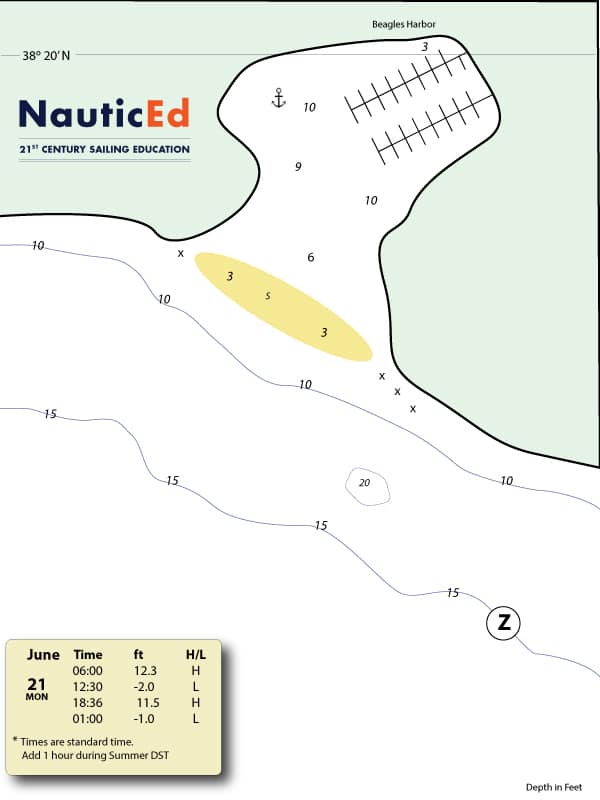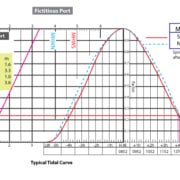Tide Calculation Pop Quiz
Here’s is a quick few tidal problems for you to solve
You’re heading up the coast to Beagles Harbor on June 21st for the weekend.
See the Chart Section below. From the tide charts, you know that Beagle sound follows a semi-diurnal tidal flow.
(1) What is the water depth at point Z at 0800, 1015, 1230?
(2) What is the water depth over the sand bar at 1600?
(3) The Skipper would like to enter Beagles Harbor. What is the earliest time in the afternoon the Skipper could cross the sandbar to the harbor given that the Skipper would like some safety depth under the keel?
Complete the draw and safety situations below
A) Draw = 4.5 ft Safety=2 ft
B) Draw= 4.0 ft Safety=1.0 ft
C) Draw = 4.5 ft Safety=2.5 ft
Use Rule of Twelves and linear interpolation between times if needed
First Understand the Rule of Twelves’
The rule of twelves’ is not a bad approximation to sinusoidal curve and most normal tides follow a sinusoidal curve. The rule of twelves’ is not 100 % but usually close enough.
If a tide is a semi-diurnal tide curve, it means the tide changes twice in 1 day or two high tides or two low tides in one day. This means about 6 hours between a high and a low. The rule of twelves’ means that over each hour between a high and a low, the tide height changes by multiples of twelves in the following manner.
After a high or low
- 1st hour – 1/12 of the range
- 2nd hours – 3/12 of the range
- 3rd hours – 6/12 of the range
And before a high or a low
- 1st hour – 1/12 of the range
- 2nd hours – 3/12 of the range
- 3rd hours – 6/12 of the range
For example: for a 12-foot range with a high of 12 ft at noon and a low of 0 ft at 6:00 pm
After High Tide
- At 1 pm the tide will have lowered from the high by 1 foot
- At 2 pm the tide will have lowered from the high by 3 feet
- At 3 pm the tide will have lowered from the high by 6 feet
Before Low Tide
- At 4 pm the tide will above the 6 pm low by 3 feet
- At 5 pm the tide will above the 6 pm low by 1 foot
It is important to work the numbers to the closest high or low because the tide change is never exactly 3 hours. For example, if the high was noon but the low was 6:30 then you would do the following.
After High Tide
- At 1 pm the tide will have lowered from the high by 1 foot
- At 2 pm the tide will have lowered from the high by 3 feet
- At 3 pm the tide will have lowered from the high by 6 feet
Before Low Tide
- At 3:30 pm the tide will be above the 6:30 pm low by 6 feet
- At 4:30 pm the tide will be above the 6:30 pm low by 3 feet
- At 5:30 pm the tide will be above the 6:30 pm low by 1 foot
Notice that if you interpolate properly then the tide is really at 1/2 way between 3 pm and 3:30 pm. So at 3 pm it is really a little higher than 1/2 and at 3:30 it is really a little lower than half. Your best estimate is half the range at 3:15 pm.
To Solve The Problem
- First, get the range between the adjacent high and low tides
- Divide that range by 12 and find the 1/12, 3/12, 6/12 of the range
- Lay out a table of time 3 hours after and 3 hours before versus height
- Add in the 1/12, 3/12, 6/12 of the range before and after the relevant tide
- Calculate the tide height
- Add a datum column (the depth listed on the chart at the point of interest)
- Add the tide heights to the datum
- Then interpolate for any in-between times.
Remember: range, twelfths, table,
Continuing the simple 12-foot tide @noon example above, the table would look like this assuming you were looking at a point on the chart that listed the depth at say 8 feet and assuming it is summer (Daylight Saving Time)
| Tide Time | Time DST | Tide H/L | Range | 1/12ths | 1/12ths | Tide Height | Datum | Water Depth |
| 1100 | 1200 | 12 | 12 | 0 | 0 | 12 | 8 | 20 |
| 1200 | 1300 | 12 | 12 | 1/12 | 1 | 11 | 8 | 19 |
| 1300 | 1400 | 12 | 12 | 3/12 | 3 | 9 | 8 | 17 |
| 1400 | 1500 | 12 | 12 | 6/12 | 6 | 6 | 8 | 14 |
| 1400 | 1500 | 0 | 12 | 6/12 | 6 | 6 | 8 | 14 |
| 1500 | 1600 | 0 | 12 | 3/12 | 3 | 3 | 8 | 11 |
| 1600 | 1700 | 0 | 12 | 1/12 | 1 | 1 | 8 | 9 |
| 1700 | 1800 | 0 | 12 | 0 | 0 | 0 | 8 | 8 |
If you make a table like the above, it will be difficult to make a mistake
Common mistakes to avoid
- Confusing the difference between datum, tide height, and water depth.
- Datum: The listed depth on the chart which is the average of the lower low high tides.
- Tide height: at a specific time, where is the height of the water throughout its sinusoidal curve cycle between the listed low tide and the listed high tide
- Water depth: The datum depth list on the chart plus the tide height at a specific time.
- Confusing daylight savings time.
- In summertime, add one hour to the listed low and high tide times listed in the tide almanac
Interpolation
Interpolation comes in when you want to find the depth at a time between times listed on the table.
- For example, what is the water depth at 1630 above? This is 1/2 way between 11 ft and 9 ft = 10 ft.
- Or a different question might be: At what time is the water depth 18 ft? This is 1/2 way between 1300 and 1400 = 1330
Answers
The answers are in this attached PDF. DO NOT cheat and download now. Give the above a real proper go first. If you create the tables as above you will get the answers simply and be able to understand practical applications of tides well using the rule of twelves’.
Before jumping in too fast, there is one tiny detail you need to think about before diving in too fast as well. Hint what is the latitude?
Coastal Navigation Course
This Coastal Navigation Clinic is quite possibly one of the best values on the Internet. For just $39, you will fully understand the fundamentals of Coastal Navigation and be able to practically apply them wherever you go.
Bareboat Charter Master Course
*Includes Coastal Nav Course* Become a Bareboat Charter Master - a comprehensive online course for multi-day near coastal sailing and bareboat chartering internationally.
Start with 2 Free Sailing Courses
Sign-up and get 2 free courses and a free sailing eLogbook to build your sailing resume for charter companies worldwide.
Author
-
My vision for NauticEd is to ensure that families and friends get out on the water not only safely but with true COMPETENCE, confidently savoring every moment of their valuable time.
Achieving this means being the pinnacle of sailing and boating education—offering comprehensive multi-media theoretical instruction coupled with hands-on, on-the-water training through our global network of American National Standards Instructors. We steadfastly avoid becoming a mere certification mill; our focus is on delivering genuine competence, ensuring our students are well-prepared for enjoyable, real-world boating experiences.
View all posts








